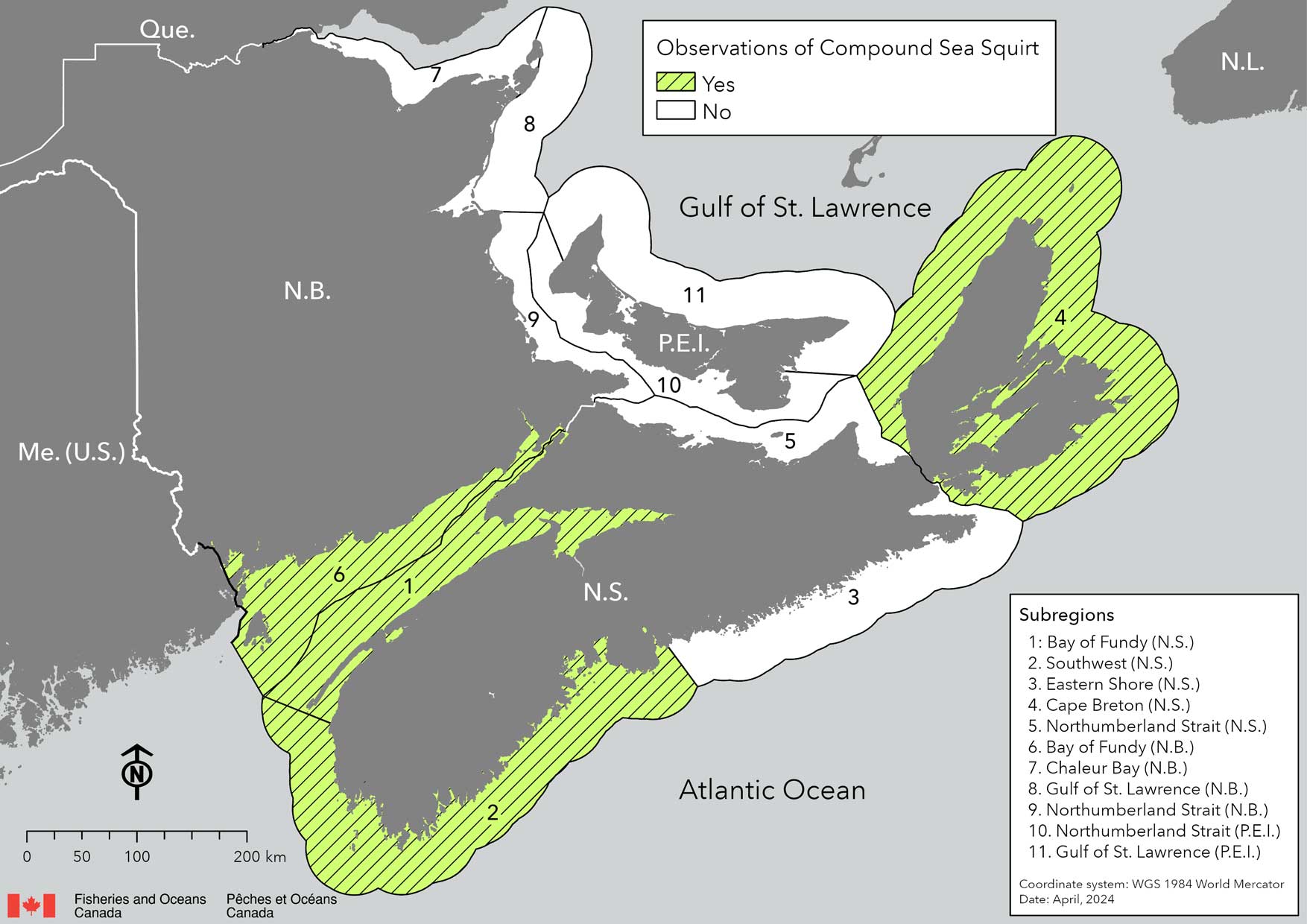Compound sea squirt
Diplosoma listerianum
Report it
If you think you have found an aquatic invasive species:
- do not return the species to the water
- take photos
- note:
- the exact location (GPS coordinates)
- the observation date
- identifying features
- contact us to report it
On this page
- Origin and distribution
- Identifying features
- Habitat
- Ecological and economic impacts
- Mode of dissemination
- Government action
- For further information
- References
Compound sea squirt is an invasive colonial tunicate primarily seen in tropical and temperate waters.
Origin and distribution

Observed distribution of Compound Sea Squirt in subregions of Canada's Maritime provinces.
Note: Observation within a subregion does not mean the species is found throughout it. Lack of observation within a subregion does not mean the species is absent from that subregion. It means that it has not been observed there.
The Compound Sea Squirt is an invasive colonial tunicate that probably originates from northern Europe. It has been present in British Columbia since at least the 1980s and has also spread along the American east coast. In 2008, it was found in Atlantic Canadian waters for the first time, off the Magdalen Islands. The species was subsequently observed in southwest Nova Scotia in 2012, and has since been reported in other areas of Nova Scotia and southern New Brunswick.
Identifying features
- Dense colonies that are soft, jelly-like, and translucent
- Forms fragile sheets which are hard to remove without tearing
- Colour: darkish grey
- Large openings sometimes spotted with white dots
- Colonies can reach up to 20 centimetres in size
- Individuals within a colony are cylindrical and approximately 2 milimetres long
Similar species (native)
Compound Sea Squirt may resemble certain types of sponges, but its texture is gelatinous rather than spongy.
Compound Sea Squirt may also be mistaken for Jelly Bryozoan (Alcyonidium gelatinosum), but this native bryozoan does not have the characteristic openings of tunicates.
Habitat
Compound Sea Squirt grows below the level of the tide down to 80 metres depth. It often attaches to algae and eelgrass, as well as any hard substrates, including rocks, vessels, and pontoons.
Ecological and economic impacts
The potential impacts following the introduction and establishment of the Compound Sea Squirt are widespread. Coastal ecosystems are particularly vulnerable for many reasons including high shipping, recreational traffic and disturbance events. It may outcompete other organisms for food and space, thereby altering the natural community dynamics, in a short period of time. This species threatens aquaculture, fishing and other coastal and offshore activities. It increases the weight of aquaculture cultivation gear, causing work to be more demanding as well as increasing the operating costs for shellfish producers and processors.
Mode of dissemination
The most plausible mode of introduction of the Compound Sea Squirt to North America is through hull fouling (that is, attached to the outside of a boat or other watercraft), as the larvae have a short free-swimming stage and thus are unlikely to be transported in ballast water.
The increases in area occupied by aquaculture activities in the last two decades have led to an expansion of underwater surfaces available for colonization by the Compound Sea Squirt. It has been observed that the growth of invasive ascidians, in temperate regions, is facilitated as the waters get warmer.
Government action
Scientific research
Fisheries and Oceans Canada is monitoring the distribution of invasive biofouling species (that is, aquatic species that live attached to hard surfaces) on the Atlantic and Pacific Coasts to detect new invasions and track the spread of Compound Sea Squirt.
For further information
- Canadian Science Advisory Secretariat (CSAS) Publications
- Invasive Tunicate - Fact Sheet
- Biological Synopsis of the Compound Sea Squirt (Diplosoma listerianum) (PDF)
Fisheries and Oceans Canada – 2011 - Risk Assessment for Two Solitary and Three Colonial Tunicates in Both Atlantic and Pacific Canadian Waters
(CSAS resdocs - 2007/063) Fisheries and Oceans Canada - Research Document 2007/063
References
- Bullard, S. G., Lambert, G., Carman, M. R., Byrnes, J., Whitlatch, R. B., Ruiz, G., & Pederson, J. (2007). The colonial ascidian Didemnum sp. A: current distribution, basic biology and potential threat to marine communities of the northeast and west coasts of North America. Journal of Experimental Marine Biology and Ecology, 342(1), 99-108.
- Mackenzie, A.B. 2011. Biological synopsis of the compound sea squirt (Diplosoma listerianum). Can. Manuscr. Rep. Fish. Aquat. Sci. 2966: v + 18 p.
- Therriault, T. W., Herborg, L. M., & Department of Fisheries and Oceans, Ottawa, ON (Canada); Canadian Science Advisory Secretariat, Ottawa, ON (Canada). (2008). Risk assessment for two solitary and three colonial tunicates in both Atlantic and Pacific Canadian waters. Canadian Science Advisory Secretariat. Secrétariat canadien de consultation scientifique.
- Date modified:



